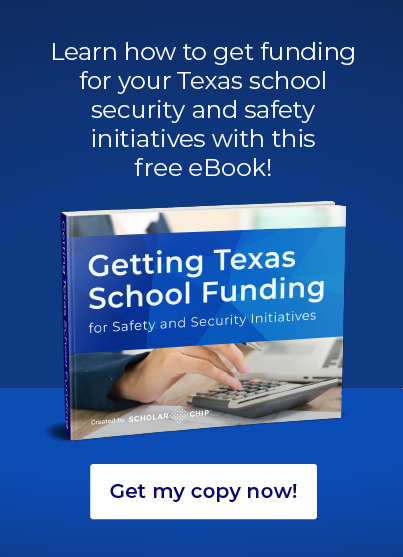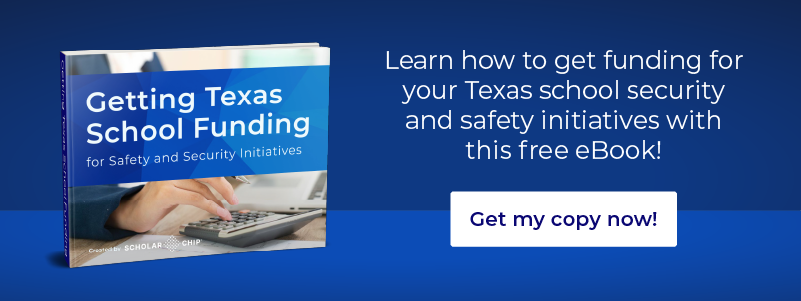Because school shootings are horrific, seemingly random, and so antithetical to a school’s primary mission, each incident draws intense media attention. An attack anywhere in the country sends frightened parents to school board meetings to demand action. School leaders have been pushed to prioritize security, often at the expense of education programs and capital improvements. Federal and state legislators have stepped up by creating grant programs to assist schools with security upgrades.
The February 2018 Parkland, Florida, shooting prompted the Trump administration to form the Federal Commission on School Safety. The Commission’s final report was the impetus for a series of grant programs launched by the US Department of Education.
Texas schools have not been immune to violence. In response to the May 2018 Santa Fe High shooting, Texas legislators put together a $100-million grant program to shore up safety in Texas schools. The availability of state and federal grants ebbs and flows. Recipients need to make the most of awards because future funding is never guaranteed. To best use security funds, school leaders must identify the most prevalent threats and implement proven security measures to address security weaknesses.
How Schools Have Responded to Violence
The data shows that most school districts will never have to deal with the tragedy of a school shooting. Other, non-fatal violent acts—bullying, fighting, etc.—are far more common and more likely to create a hostile climate and disrupt education. Nonetheless, school security in the form of hardening buildings has become a multi-billion-dollar industry. According to the National Center for Education Statistics, most schools have addressed security by locking and monitoring building entrances, installing security cameras, and requiring faculty and staff to wear identification badges.
Increasingly, schools have been working with law enforcement to establish a police presence on campus. According to Governor Abbot’s August 2019 report on the Texas School Safety Initiative, 265 DPS troopers are stationed in the state’s schools, and the number of school marshals has increased by 325%. Will these measures be effective in preventing another shooting?
The National Association of School Psychologists conducted a review of studies on the effectiveness of school security measures. The report found no evidence that security systems such as surveillance cameras, metal detectors, and security guards were effective in preventing violence. These overt measures may even contribute to a hostile environment, making schools less safe. Such measures, the NASP reports, may influence students’ perceptions that school is dangerous and promote the influence of a street culture that emphasizes individual survival over community.
While building security is essential, creating a prison-like atmosphere may undermine efforts to make schools safe. A holistic, school-friendly approach that addresses the most common threats may be a more effective way to secure buildings.
Prevalent Threats Schools Face Today
In the NCES 2018 Indicators of School Crimes and Safety survey, 18.9% of ninth- to twelfth-grade students in Texas schools reported that they had been bullied at school during the past year. These incidents ranged from name-calling to physical altercations (tripping, pushing, and shoving). Nearly 21% of Texas high school students reported that they had been in a physical fight on school grounds.
Nationwide, 6.7% of students say that they had skipped school at least one day in the past month out of concern for their safety. In addition to impeding student success, chronic absenteeism creates fractures in the school community that weaken safety. Unaddressed behavioral issues further add to a negative school climate. When the school culture becomes one of alienation and fear, safety is compromised.
Findings of the Federal Commission on School Safety
The Federal Commission on School Safety analyzed more than twenty years of reports and data on school shootings. The final report concludes that there exists no profile that may be used to identify a potentially violent student. Age, family background, and academic ability appear to play no role. The one commonality seemed to be that students who direct violence against their teachers and peers felt isolated and often were victims of bullying.
Fostering a sense of community that engenders trust between students and adults, promoting values such as fairness, respect, and personal responsibility, and celebrating individual and group successes will create an environment where students will not be afraid to come to school and can focus on academics rather than safety concerns. New technologies can facilitate school climate improvement plans to enhance security while maintaining a welcoming environment.
Identity Management Systems
RFID technology makes it possible to control building access and automate attendance with chip-embedded ID cards. With a smart ID system, students and school personnel tap or swipe their ID cards to enter the building and record their presence. This creates a real-time record of who is in the building, essential information in the event of an emergency. Students become responsible for recording their own attendance, giving them a greater sense of autonomy. Mobile card readers allow the system to work outside the buildings to monitor attendance on buses and field trips. With powerful reporting functions, these systems allow for quick identification of students with attendance issues, so problems may be addressed before they become chronic.
Building Security
School administrators know that incidents of bullying and fighting happen most often in unsupervised areas of the building. Hall monitors cannot be everywhere at all times. With smart ID systems, restricted areas of the building may be locked down. Cardholders who need to access these areas will have permission programmed into their identity profile. Permissions may be revoked from a central dashboard. From this same dashboard, an administrator may quickly lock or unlock any or all doors in a building.
Vendors, substitutes, parents, and volunteers arrive at a school’s entrance all throughout the day. State-of-the-art visitor management systems utilize card readers with the capability to connect a visitor’s ID—a driver’s license or other government ID—with sex offender registries and to cross-reference names with an SIS database for orders of protection and custody issues on file. The benefit is clear: Those who should not be allowed entrance will be flagged. The visitor management system will issue a temporary ID badge for approved visitors and store names, dates, and times, enabling administrators to monitor building activities.
Behavior Management Systems
A student’s behavior records are often an assortment of notes handwritten by teachers, guidance counselors, and administrators, along with carbon copies of referral forms. The application of school rules and consequences for violations may be inconsistent. This reinforces students’ perception that some teachers are “easier” than others, a belief that helps students evade responsibility for their actions.
With paperless, automated behavior management systems, teachers enter behavior information, both negative and positive, and the data is organized in one place. These systems may be integrated with attendance systems so teachers and counselors may get a complete behavior picture and develop effective interventions. Comprehensive systems include learning and assessment components. Student misbehavior may stem from delayed social-emotional development. Video-based testing and learning modules measure a student’s understanding of social norms, and students can develop social-emotional skills by completing self-paced lessons.
Texas schools that have been awarded grants under SB500 or have received a federal grant for security upgrades may gain the greatest benefit by investing some of those funds into replacing legacy technology with new, integrated systems. Hardening physical facilities is appropriate in many instances, but these measures are best implemented alongside efforts to improve school climate and create a welcoming environment that encourages communication and inclusion. Contact ScholarChip to learn how an investment in new technology can enhance security in your schools.
ScholarChip offers a solution called Alternative Behavior Educator (ABE). This innovative program enables school administrators and counselors to identify, monitor, and improve student behavior throughout a student’s career, while giving them powerful data-driven reports that quickly flag at-risk students, help monitor and chronicle progress, and help them identify school safety risks before incidents.
To learn how ScholarChip can help make Texas schools safer or get free recommendations, feel free to chat with one of our specialists today!


